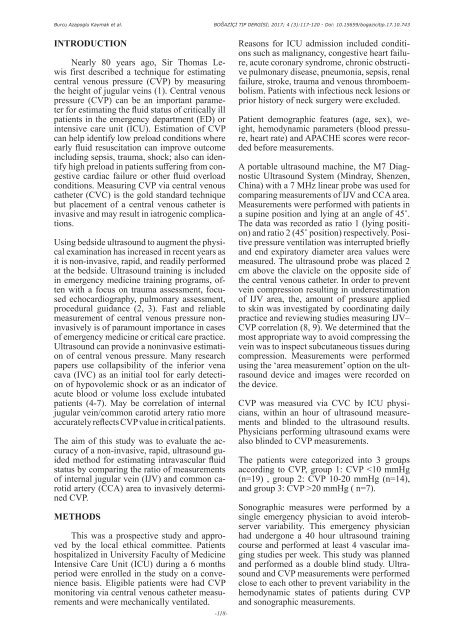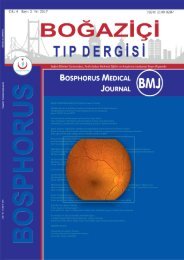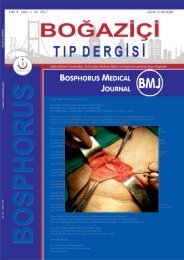2017-4-3
Create successful ePaper yourself
Turn your PDF publications into a flip-book with our unique Google optimized e-Paper software.
Burcu Azapoglu Kaymak et al.<br />
BOĞAZİÇİ TIP DERGİSİ; <strong>2017</strong>; 4 (3):117-120 - Doi: 10.15659/bogazicitip.17.10.743<br />
INTRODUCTION<br />
Nearly 80 years ago, Sir Thomas Lewis<br />
first described a technique for estimating<br />
central venous pressure (CVP) by measuring<br />
the height of jugular veins (1). Central venous<br />
pressure (CVP) can be an important parameter<br />
for estimating the fluid status of critically ill<br />
patients in the emergency department (ED) or<br />
intensive care unit (ICU). Estimation of CVP<br />
can help identify low preload conditions where<br />
early fluid resuscitation can improve outcome<br />
including sepsis, trauma, shock; also can identify<br />
high preload in patients suffering from congestive<br />
cardiac failure or other fluid overload<br />
conditions. Measuring CVP via central venous<br />
catheter (CVC) is the gold standard technique<br />
but placement of a central venous catheter is<br />
invasive and may result in iatrogenic complications.<br />
Using bedside ultrasound to augment the physical<br />
examination has increased in recent years as<br />
it is non-invasive, rapid, and readily performed<br />
at the bedside. Ultrasound training is included<br />
in emergency medicine training programs, often<br />
with a focus on trauma assessment, focused<br />
echocardiography, pulmonary assessment,<br />
procedural guidance (2, 3). Fast and reliable<br />
measurement of central venous pressure noninvasively<br />
is of paramount importance in cases<br />
of emergency medicine or critical care practice.<br />
Ultrasound can provide a noninvasive estimation<br />
of central venous pressure. Many research<br />
papers use collapsibility of the inferior vena<br />
cava (IVC) as an initial tool for early detection<br />
of hypovolemic shock or as an indicator of<br />
acute blood or volume loss exclude intubated<br />
patients (4-7). May be correlation of internal<br />
jugular vein/common carotid artery ratio more<br />
accurately reflects CVP value in critical patients.<br />
The aim of this study was to evaluate the accuracy<br />
of a non-invasive, rapid, ultrasound guided<br />
method for estimating intravascular fluid<br />
status by comparing the ratio of measurements<br />
of internal jugular vein (IJV) and common carotid<br />
artery (CCA) area to invasively determined<br />
CVP.<br />
METHODS<br />
This was a prospective study and approved<br />
by the local ethical committee. Patients<br />
hospitalized in University Faculty of Medicine<br />
Intensive Care Unit (ICU) during a 6 months<br />
period were enrolled in the study on a convenience<br />
basis. Eligible patients were had CVP<br />
monitoring via central venous catheter measurements<br />
and were mechanically ventilated.<br />
-118-<br />
Reasons for ICU admission included conditions<br />
such as malignancy, congestive heart failure,<br />
acute coronary syndrome, chronic obstructive<br />
pulmonary disease, pneumonia, sepsis, renal<br />
failure, stroke, trauma and venous thromboembolism.<br />
Patients with infectious neck lesions or<br />
prior history of neck surgery were excluded.<br />
Patient demographic features (age, sex), weight,<br />
hemodynamic parameters (blood pressure,<br />
heart rate) and APACHE scores were recorded<br />
before measurements.<br />
A portable ultrasound machine, the M7 Diagnostic<br />
Ultrasound System (Mindray, Shenzen,<br />
China) with a 7 MHz linear probe was used for<br />
comparing measurements of IJV and CCA area.<br />
Measurements were performed with patients in<br />
a supine position and lying at an angle of 45˚.<br />
The data was recorded as ratio 1 (lying position)<br />
and ratio 2 (45˚ position) respectively. Positive<br />
pressure ventilation was interrupted briefly<br />
and end expiratory diameter area values were<br />
measured. The ultrasound probe was placed 2<br />
cm above the clavicle on the opposite side of<br />
the central venous catheter. In order to prevent<br />
vein compression resulting in underestimation<br />
of IJV area, the, amount of pressure applied<br />
to skin was investigated by coordinating daily<br />
practice and reviewing studies measuring IJV–<br />
CVP correlation (8, 9). We determined that the<br />
most appropriate way to avoid compressing the<br />
vein was to inspect subcutaneous tissues during<br />
compression. Measurements were performed<br />
using the ‘area measurement’ option on the ultrasound<br />
device and images were recorded on<br />
the device.<br />
CVP was measured via CVC by ICU physicians,<br />
within an hour of ultrasound measurements<br />
and blinded to the ultrasound results.<br />
Physicians performing ultrasound exams were<br />
also blinded to CVP measurements.<br />
The patients were categorized into 3 groups<br />
according to CVP, group 1: CVP 20 mmHg ( n=7).<br />
Sonographic measures were performed by a<br />
single emergency physician to avoid interobserver<br />
variability. This emergency physician<br />
had undergone a 40 hour ultrasound training<br />
course and performed at least 4 vascular imaging<br />
studies per week. This study was planned<br />
and performed as a double blind study. Ultrasound<br />
and CVP measurements were performed<br />
close to each other to prevent variability in the<br />
hemodynamic states of patients during CVP<br />
and sonographic measurements.





